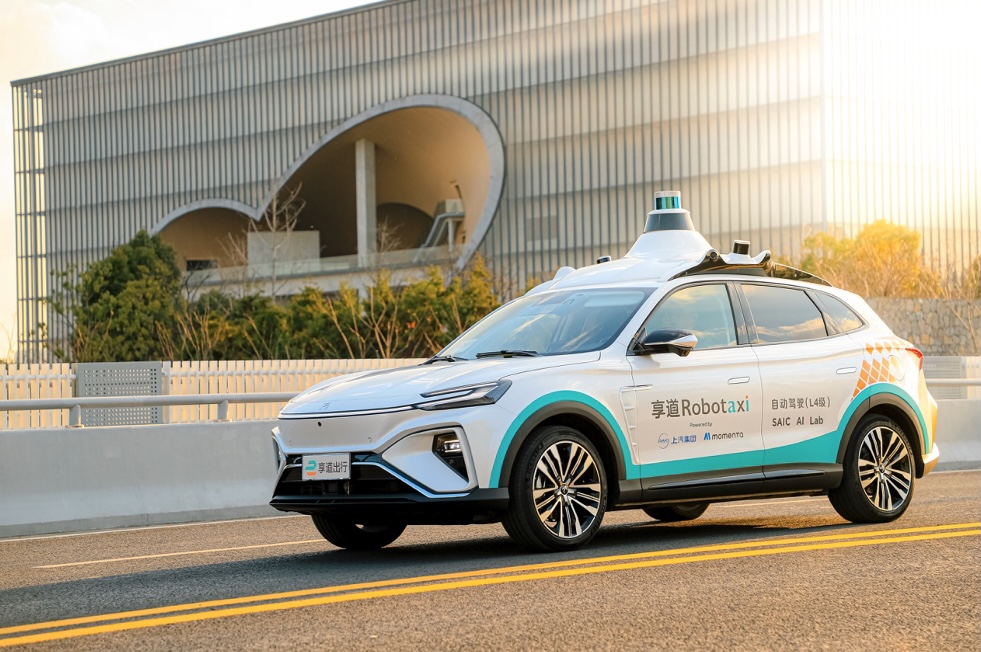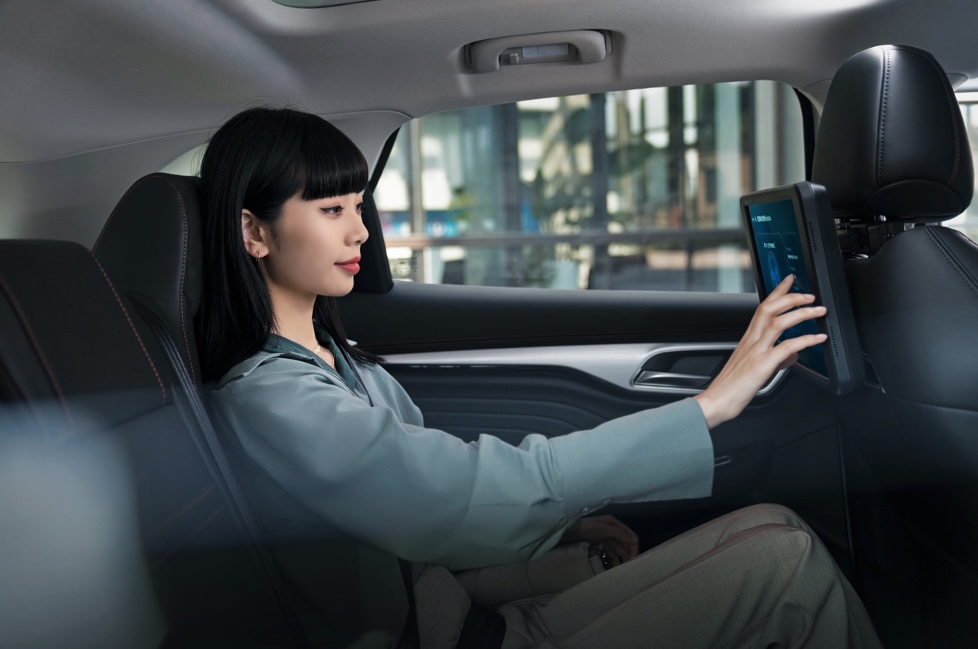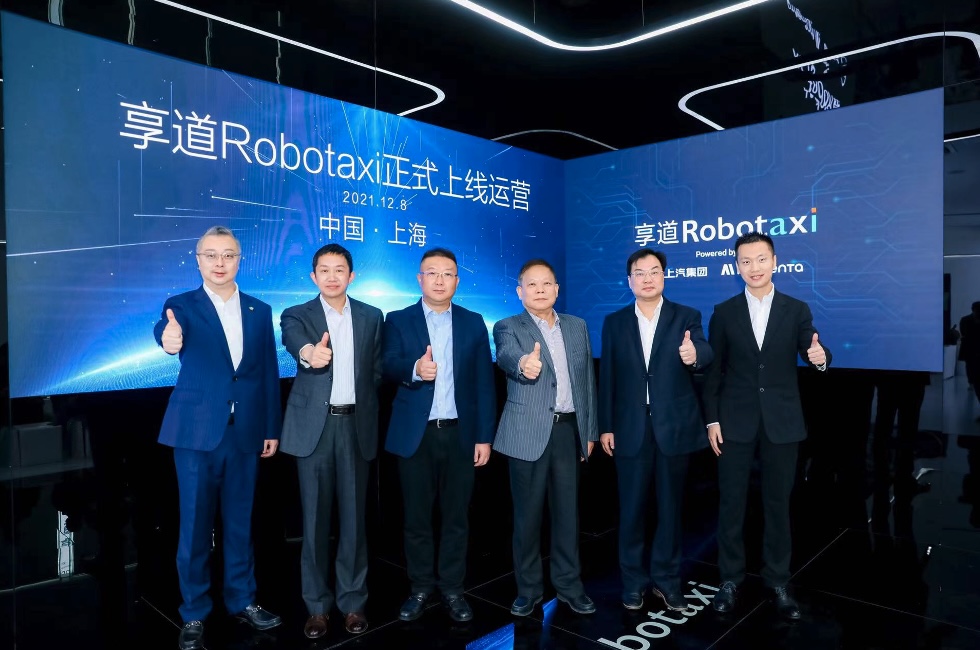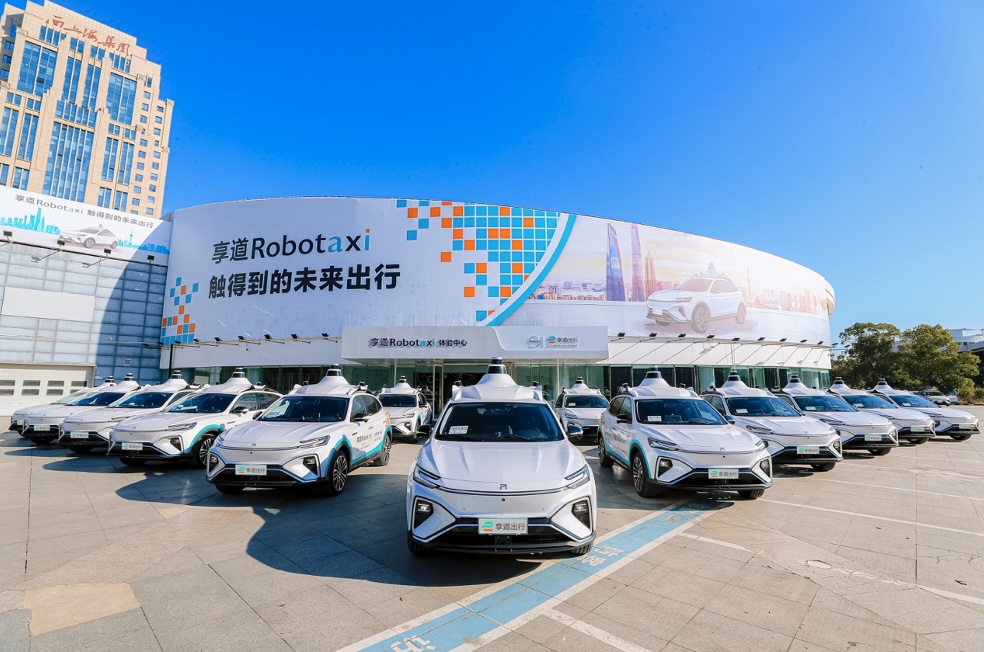On December 8, 2021, the Enjoy Road Robotaxi Experience Center was opened in Anting, Shanghai. SAIC Group’s travel brand, Enjoy Road, officially launched its “Robotaxi” travel service. Within this year, the size of the Shanghai fleet will increase from the current 20 vehicles to 40, and 20 operating vehicles will also be launched in Suzhou. In 2022, Enjoy Road Robotaxi will also land in Shenzhen, and the overall size of the operating fleet will reach 200. By 2025, SAIC Group will form a commercial robotaxi fleet.
Trinity
Enjoy Road Robotaxi is jointly created by the SAIC Artificial Intelligence Lab, Momenta, and Enjoy Road, realizing the three-in-one model of “smart manufacturing + AI + operation” end-to-end to explore new commercial models for smart travel businesses, and will be replicated on a larger scale in more cities in the future.
Smart Manufacturing: Fayan MARVEL R

The first batch of operating vehicles are Fayan MARVEL R models from SAIC Group, which have a high-strength steel proportion of 74% and are integrated and reformed with the L4 intelligent driving system software and hardware by the original factory. SAIC’s self-developed iEPS redundant line-controlled chassis products improve vehicle maneuvering accuracy and are equipped with dual-path redundant backups and a 600 TOPS computing platform.
AI: SAIC Artificial Intelligence Lab x Momenta
The SAIC Artificial Intelligence Lab and Momenta worked together to empower Enjoy Road Robotaxi with AI and provide a software and hardware integration solution for autonomous driving. They independently completed 3D perception and fusion based on data-driven redundancy to ensure multiple height redundancies of the system.
Leveraging SAIC’s Fan One Cloud platform and Momenta Framework technology, they established a full-process data-driven algorithm and efficient closed-loop automation toolchain, while ensuring data and network security, and bridging the data transfer and technology fusion between mass-produced vehicles and Robotaxi autonomous driving to provide massive data support for L4 autonomous driving and help automate rapid iteration of autonomous driving technology.
Operation: Enjoy Road
Enjoy Road has launched travel services in nearly 40 cities in China, covering ride-hailing, enterprise leasing, personal rentals, and taxis, with rich safety and compliance-oriented operation and vehicle management experience. At the same time, Enjoy Road’s artificial intelligence center completes multidimensional best matches of people, cars, times, and spaces in milliseconds to assist efficient operation.
Safety
Personal/Data SecurityThanks to Xiangdao’s rich operational management experience, Xiangdao Robotaxi safety officers undergo strict screening and professional training to ensure safe travel for users. Xiangdao Robotaxi uses data encryption, anonymization and other measures to ensure the security of personal information at every stage from end to management to cloud, and respects users’ right to know while adhering to the “in-vehicle processing” principle, comprehensively protecting the security of users’ personal information.
Information Management System
As a travel platform that has passed both ISO 27001 Information Security Management System and ISO 27701 Privacy Information Management System certifications, Xiangdao Travel has established a perfect network information security protection system for Xiangdao Robotaxi, effectively resisting network attacks and comprehensively protecting users’ personal information security.
Actual Experience

Call Experience
Citizens in the service area can directly call through the latest Xiangdao App without reservation.
Riding Experience
The trial ride time is short, but it can be seen that Xiangdao has set a benchmark for other players with Robotaxis as their commercial goals in terms of user experience.
In the customized tablets mounted on the front headrests of the car, in addition to the SR autonomous driving simulation display function, there are also controls for the air conditioning and music, which can be operated through the Enjoy-Do app on the passenger’s phone in a cloud-based manner. The voice assistant “Xiao Ke” also supports left and right zone voice recognition, controlling the corresponding side’s window opening and closing functions.
Enjoy-Do Robotaxi encourages users to share their autonomous driving experiences, allowing more people to experience the charm of future travel. During the trip, Enjoy-Do Travel App and the in-car large-screen can synchronize real-time visualization of the autonomous driving journey, and share it with one click to mainstream social platforms. In the early stage of launch, Enjoy-Do Robotaxi will also set up an autonomous driving “slow” live broadcast room on the Enjoy-Do Travel App, broadcasting the real-time dynamic picture of Enjoy-Do Robotaxi vehicles every day, and supporting one-click sharing to meet the social needs of tens of thousands of users.
Excerpt from group interview content:

Views on data factories and data closed loops from Xiang Dang, Director of SAIC Artificial Intelligence Lab and CTO of IM Auto
I think the origin of data factories is the result of the entire data application brought by automotive intelligence. Data is always there, starting from the automotive and traditional electrical interactions, data has always been information for electrical modules. However, these data will not be the root of model and algorithm iteration.
Why does everybody mention data loops today? Because it is the basis of iteration. Therefore, in Robotaxi, it is clear that we want our car models to self-iterate, self-update, and self-optimize, all of which are based on AI. Therefore, everyone in this industry has to do this thing, which is the data application mode of Robotaxi.
The construction of a data factory is actually very difficult and it will encounter all kinds of barriers. Data is divided into structured data, unstructured data, environmental data, personal behavior data, and so on. Data security is also an important consideration. Let us put aside these issues and focus on what we have done and the difficulties we have encountered in this process.
As we can clearly see, what this test really focuses on is people, cars, and objects. We need to use AI algorithms to model and perceive this world, making the model more accurate and truly understand this world. Therefore, the purpose of data is to make AI models more accurate and intelligent, which is the question we often ask.## How to Start Construction?
The first step is to clean the data and upload it after collection. After data cleaning, you need to determine what to do with the data, whether it needs training or simulation. Then, after training the model, how to provide feedback to the car and make it continue to operate.
Therefore, I believe this process is not only needed by the automotive industry, but also involves cloud management in the communication and IT industries. Previously, we collected data, but now we need to form an automatic closed loop for data, so that it can automatically turn. It is like a flywheel, which keeps turning because of its inertia. To make data unstoppable, the first thing we need to do is to automate it and form a closed loop, as I mentioned before.
I think every car manufacturer needs to focus on this new thing, and it requires support from computer science, communication, industrialization, and big data processing. Therefore, it is not just the automotive industry’s thing, but a cross-border integration of the whole industry.
I said that the flywheel needs to start, and every factory will start. Eventually, the whole world will turn, and the automotive industry will turn too. Because there will always be some data that will be shared, and I believe that V2X data will be shared. If this is resolved, I believe that data will become more and more closed-loop, and thus the problem will be solved.
Momenta CEO Cao Xu Dong believes that Robotaxi is a strategic layout
Currently, Robotaxi is like a child, a child who has just learned to walk and does not walk very well yet. However, true autonomous driving technology should be an adult and the process of development will be relatively long.
Why does it take so long? The reason is that many artificial intelligence products have a long period from development to reaching a level close to that of a human. Taking face recognition technology as an example, it is now very mature. The level of face recognition technology is now millions of times better than that of human face recognition, and it can find you among billions of faces. This technology is pretty amazing.
The development of this technology from R&D to becoming close to human took a long time. If we do not consider the breakthroughs in deep learning technology, it may take several decades to develop. If we take into account the breakthroughs in deep learning technology, it took from 2011 to 2015 to reach a level close to that of a human. However, from 2016 to 2020, it suddenly exceeded human performance by a million times.Therefore, Robotaxi may seem to have a long development cycle, but if we don’t start now, we’ll miss the window of opportunity to surpass human drivers, which is estimated to be around 3 to 4 years away. This presents both a huge challenge and a huge opportunity, and we can’t wait until it’s too late to pursue it. Impossible is not an option, because it’s our opportunity, yours and mine.
Despite the many challenges that Robotaxi technology still faces, many companies are strategically positioning themselves for Robotaxi at this time. SAIC’s collaboration with us places us in a leading position in the industry, not only in terms of vehicle size, but also in terms of Robotaxi and technology maturity.
Sharing by Cai Bin, Chairman of Xiangdao Travel, on the promotion of the Robotaxi project
As I mentioned earlier, Xiangdao Travel became the first domestic car company to launch actual L4 autonomous driving operations on Robotaxi. One of the concerns is how to develop and control future development space. This is based on several factors, the first of which is government policies and regulations. Our current operating area is relatively concentrated, located in Jading district.
We will also design a longer route, which requires active communication with government departments. Government departments will be very concerned about this project, and we may have a long route, such as from Jading to Hongqiao Airport to serve our corporate clients. In fact, I think we have confidence in operating on normal city roads, even under complex road conditions. Traffic and passenger flows in Jading are relatively low, but we have conducted experiments under normal urban road conditions.
We have also been fined for “dual-handed” use, as the face recognition technology used in Robotaxi is very powerful and it takes photos as soon as a passenger steps out of the car, which is a violation. The first thing we need is policies and regulations, as well as technology and user experience. Actually, user experience is also a very important driving force, otherwise we will be passive. As mentioned earlier, many car companies, as well as Internet companies, are also pushing out some products.
I have ridden in Xiangdao Robotaxi once and compared it with others. There are still some differences. Although every company emphasizes user needs as the driving force behind product and technological innovation, and the high integration of products, when it comes to integrating a new project, from development, design, manufacturing to final operation, there are inevitably differences in depth between each stage. We are not saying who is better than who, but we have always placed user needs and experience at the center of our product innovation and technological innovation.Actually, we mentioned the product features just now. We are still user-oriented because from the perspective of the operator, autonomous driving emphasizes cost reduction by liberating the driver, and artificial intelligence greatly reduces it. Currently, there must be safety personnel and a takeover regulation, but the ultimate goal is definitely autonomous driving. However, I think that the saving of labor costs is just one demand, and there is another demand for what users experience in the travel space, that is, the safety of a mobile tool is very important. The safety experience brought by a veteran driver makes you feel at ease in the car.
The second part talks about two scenarios, a mobile cinema and a mobile office. Therefore, there is a demand for entertainment, leisure, and office work, which amplifies the attributes of the space inside the car. This is very important. We need to define how we interpret user demands as an operating and technological enterprise, and then satisfy them through technological solutions.
These are also explicit pain points of user demand, as well as some implicit ones that may not be met and require continuous iteration. From this point of view, we believe that Xiangdao Robotaxi has differences from other products, and we must build differentiated experiences in this regard.
🔗Source: Xiangdao
This article is a translation by ChatGPT of a Chinese report from 42HOW. If you have any questions about it, please email bd@42how.com.
